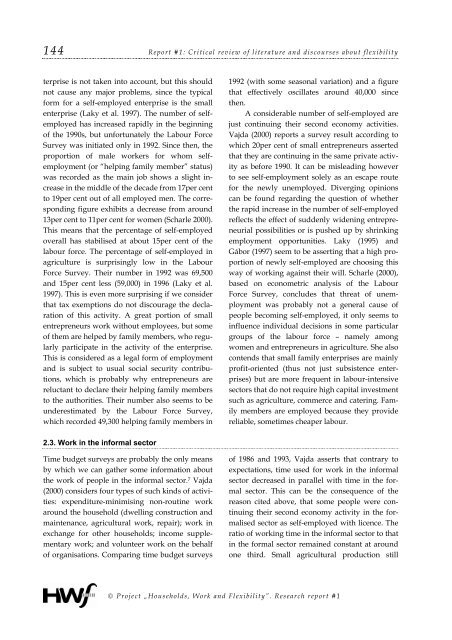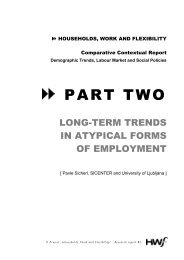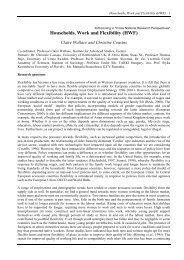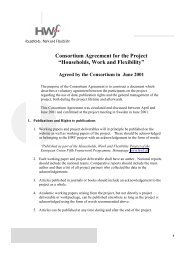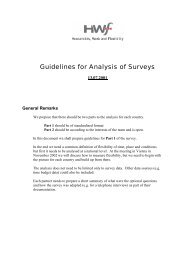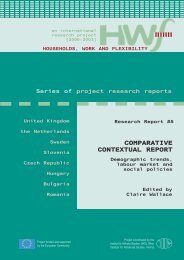CRITICAL REVIEW OF LITERATURE - HWF
CRITICAL REVIEW OF LITERATURE - HWF
CRITICAL REVIEW OF LITERATURE - HWF
You also want an ePaper? Increase the reach of your titles
YUMPU automatically turns print PDFs into web optimized ePapers that Google loves.
144 Report #1: Critical review of literature and discourses about flexibilityterprise is not taken into account, but this shouldnot cause any major problems, since the typicalform for a self-employed enterprise is the smallenterprise (Laky et al. 1997). The number of selfemployedhas increased rapidly in the beginningof the 1990s, but unfortunately the Labour ForceSurvey was initiated only in 1992. Since then, theproportion of male workers for whom selfemployment(or “helping family member” status)was recorded as the main job shows a slight increasein the middle of the decade from 17per centto 19per cent out of all employed men. The correspondingfigure exhibits a decrease from around13per cent to 11per cent for women (Scharle 2000).This means that the percentage of self-employedoverall has stabilised at about 15per cent of thelabour force. The percentage of self-employed inagriculture is surprisingly low in the LabourForce Survey. Their number in 1992 was 69,500and 15per cent less (59,000) in 1996 (Laky et al.1997). This is even more surprising if we considerthat tax exemptions do not discourage the declarationof this activity. A great portion of smallentrepreneurs work without employees, but someof them are helped by family members, who regularlyparticipate in the activity of the enterprise.This is considered as a legal form of employmentand is subject to usual social security contributions,which is probably why entrepreneurs arereluctant to declare their helping family membersto the authorities. Their number also seems to beunderestimated by the Labour Force Survey,which recorded 49,300 helping family members in1992 (with some seasonal variation) and a figurethat effectively oscillates around 40,000 sincethen.A considerable number of self-employed arejust continuing their second economy activities.Vajda (2000) reports a survey result according towhich 20per cent of small entrepreneurs assertedthat they are continuing in the same private activityas before 1990. It can be misleading howeverto see self-employment solely as an escape routefor the newly unemployed. Diverging opinionscan be found regarding the question of whetherthe rapid increase in the number of self-employedreflects the effect of suddenly widening entrepreneurialpossibilities or is pushed up by shrinkingemployment opportunities. Laky (1995) andGábor (1997) seem to be asserting that a high proportionof newly self-employed are choosing thisway of working against their will. Scharle (2000),based on econometric analysis of the LabourForce Survey, concludes that threat of unemploymentwas probably not a general cause ofpeople becoming self-employed, it only seems toinfluence individual decisions in some particulargroups of the labour force – namely amongwomen and entrepreneurs in agriculture. She alsocontends that small family enterprises are mainlyprofit-oriented (thus not just subsistence enterprises)but are more frequent in labour-intensivesectors that do not require high capital investmentsuch as agriculture, commerce and catering. Familymembers are employed because they providereliable, sometimes cheaper labour.2.3. Work in the informal sectorTime budget surveys are probably the only meansby which we can gather some information aboutthe work of people in the informal sector. 7 Vajda(2000) considers four types of such kinds of activities:expenditure-minimising non-routine workaround the household (dwelling construction andmaintenance, agricultural work, repair); work inexchange for other households; income supplementarywork; and volunteer work on the behalfof organisations. Comparing time budget surveysof 1986 and 1993, Vajda asserts that contrary toexpectations, time used for work in the informalsector decreased in parallel with time in the formalsector. This can be the consequence of thereason cited above, that some people were continuingtheir second economy activity in the formalisedsector as self-employed with licence. Theratio of working time in the informal sector to thatin the formal sector remained constant at aroundone third. Small agricultural production still© Project „Households, Work and Flexibility”. Research report #1


